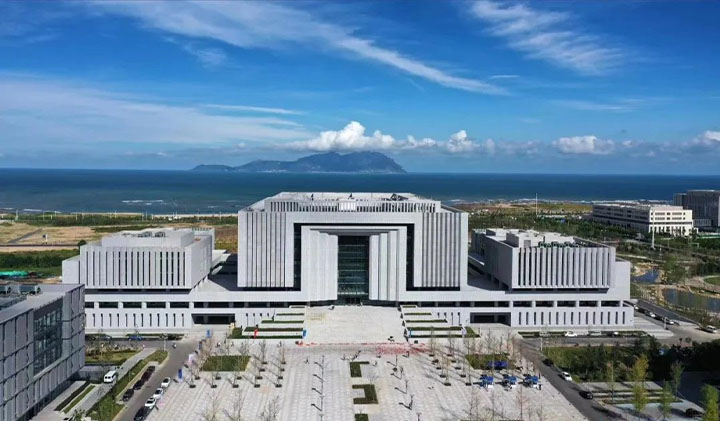Huawei Elevates OUC's Campus Network with Comprehensive All-Optical Upgrade
Enterprise products, solutions & services
In October 2021, China released the Notice on Improving University Campus Network Management and Service Quality, emphasizing that universities needed to plan for and construct facilities, such as optical cables and indoor distributed systems, to improve campus network performance and to push the co-construction and sharing of campus infrastructure forward. At the same time, universities should also further enhance their capabilities in network O&M to provide a green, secure, and stable network environment.
The Ocean University of China (OUC) has also joined the efforts of network construction to improve campus network management, service quality, user experience, and overall security. By partnering with Huawei, OUC has embarked on a comprehensive campus network overhaul, ensuring a solid all-optical foundation for a smart campus.

Established in 1924, OUC is a key comprehensive university with unique strengths in oceanography and fisheries. With four campuses and over 32,000 students, OUC has been driving the construction of a whole-chain network service support system for building smart campuses.
During this process, OUC faced four major challenges:
Terminal connection: A massive number of terminals—asset tags, electric meters, sensors, and more—connect to OUC's networks via Ethernet, Wi-Fi, RFID, and other protocols. This complex web makes terminal access and management a daunting task. Additionally, the surge in smart classrooms and online classes has created unprecedented demands on network bandwidth.
Private-network convergence: Due to the different network applications of school systems, wired, wireless, and Internet of Things (IoT) networks are constructed separately, causing repeated investment. Private networks, such as online classes, all-in-one cards, research, and security networks are independent from one another, creating severe data silos. In addition, having numerous ELV rooms and excessive cabling drives up the total cost of ownership (TCO).
O&M:Network O&M is complex while the OUC campus is understaffed, with fewer than 10 O&M technicians available. As a growing number of network elements (NEs) are added on campus, management nodes increase as well, leading to the exponential growth of manual O&M difficulties.
Security Risks: Here, security indicates the security of terminals, networks, and data. However, with extended network security protection borders and forged IoT terminals, security risks have significantly increased. Therefore, security capabilities need to be enhanced to protect the intranet and extranet.
With the accelerated construction of gigabit optical networks, fiber in and copper out has become a clear trend. An all-optical campus network helps the education industry to advance faster on the information highway. OUC followed in the industry's footsteps by using the Huawei FTTO solution to enhance the base of campus networks, so as to overcome these challenges.
During the campus network upgrade, OUC's collaboration with Huawei led to the adoption of an IP network combined with the FTTO integrated solution. This amalgamation enhances network efficiency, reliability, simplicity, and agility. Key attributes of this solution include:
1. Simplified architecture
To realize high-speed transmission and reliable interconnections between campuses, OUC deploys an end-to-end 100G optical transmission network (OTN) to form an all-optical base with low latency, high bandwidth, and strong reliability. This network enables high-speed data center disaster recovery and unified authentication across all four campuses. It also routes fibers directly to terminals for multi-service bearing and easy service expansion.
2. Ultra-fast broadband
OUC taps into the Wi-Fi 6 technology that provides high bandwidth and concurrency to realize ultra-fast transmission, stable connections, and intelligent networking. It also supports a massive number of connections, and even the concurrent access of all teachers and students with no frame freezing and imperceptible latency.
3. Easy O&M
Thanks to the multi-network convergence at OUC, all-scenario services can be transported on one all-optical network. The university also deploys the eSight ICT and iMaster NCE network management systems (NMS) for real-time visualization and precise fault locating.
4. Easy evolution
Leveraging the wavelength division (WD) technology and P2MP architecture, OUC has built a 48-wavelength 100G transmission system which supports plug-and-play capabilities for ONUs. With one fiber catering to a wide range of services, from video to data and voice, network expansion becomes more manageable, ensuring seamless evolution over the next 10 years.
Nowadays, FTTO has become an optimal bearer solution for future campus network deployment. In the practice of OUC, the IP network + FTTO combination can better meet its demands of high-speed transmission and massive connections as well as ensure stable and reliable network connections. The solution also prepares the network for future evolution.
With wired, wireless, and IoT converged networks based on FTTO, all people, events, and objects at OUC can access the network at any time. It also supports information transfer for teaching, scientific research, management, logistics, and campus operation services.
Campus network construction
In the CO equipment room, OLTs are deployed in one cabinet to manage up to 10,000 information points, which facilitates centralized remote management and saves the cabling space by 60%. Passive components eliminate the need for ELV power supply, enhancing energy efficiency. Fibers are routed to the teaching buildings, libraries, classrooms, and dormitories, and outdoor intelligent poles connect directly to terminals such as indoor APs, wireless PCs, video conferencing devices, and security cameras.
Campus network experience
Wi-Fi 6 coverage extends throughout the campus, with 2.5G upstream interfaces maximizing Wi-Fi 6 potential. Eight spatial streams are provided to ensure bandwidth experience in the case of high concurrency. Together with Huawei's 5G application acceleration technology, transmission latency is reduced to 10 ms. Even water meters are connected to Wi-Fi for water usage data backhaul.
OUC has also deployed a wireless network quality assessment system to identify and visualize network performance, driving the continuous improvement of user experience. In addition, OUC implements unified wired and wireless authentications for its four campuses, enabling easy and convenient access to the campus network for teachers and students.
Campus network management
Automatic provisioning and management are automated, enabling rapid service deployment. FTTO + PON + WLAN integration streamlines O&M while enhancing network performance visualization. Moreover, multi-dimensional network monitoring on the NMS makes one-click fault locating possible.

OUC's partnership with Huawei marks a significant leap toward an intelligent campus network and an enriched campus life. With FTTO serving as the foundation, OUC is poised to promote advanced education and enrich its disciplines and research in the coming years. Huawei's FTTO solution paves the way for smart campuses to support talent cultivation, seamlessly integrate teaching, scientific research, and management, and ultimately promotes a thriving education industry.